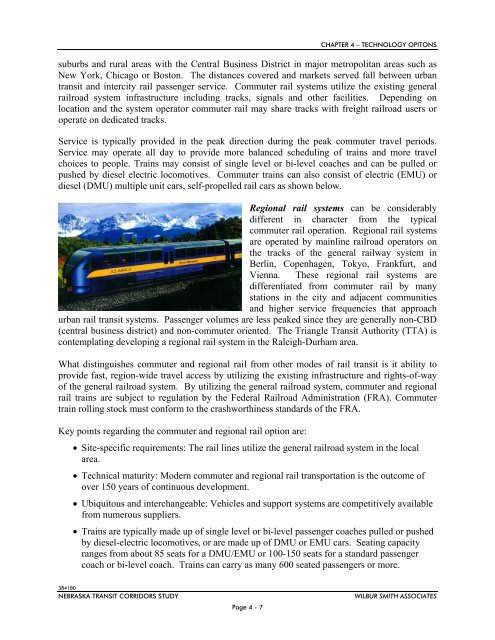NTRAC Final Study - Nebraska Department of Roads - State of ...
NTRAC Final Study - Nebraska Department of Roads - State of ...
NTRAC Final Study - Nebraska Department of Roads - State of ...
You also want an ePaper? Increase the reach of your titles
YUMPU automatically turns print PDFs into web optimized ePapers that Google loves.
CHAPTER 4 – TECHNOLOGY OPITONS<br />
suburbs and rural areas with the Central Business District in major metropolitan areas such as<br />
New York, Chicago or Boston. The distances covered and markets served fall between urban<br />
transit and intercity rail passenger service. Commuter rail systems utilize the existing general<br />
railroad system infrastructure including tracks, signals and other facilities. Depending on<br />
location and the system operator commuter rail may share tracks with freight railroad users or<br />
operate on dedicated tracks.<br />
Service is typically provided in the peak direction during the peak commuter travel periods.<br />
Service may operate all day to provide more balanced scheduling <strong>of</strong> trains and more travel<br />
choices to people. Trains may consist <strong>of</strong> single level or bi-level coaches and can be pulled or<br />
pushed by diesel electric locomotives. Commuter trains can also consist <strong>of</strong> electric (EMU) or<br />
diesel (DMU) multiple unit cars, self-propelled rail cars as shown below.<br />
Regional rail systems can be considerably<br />
different in character from the typical<br />
commuter rail operation. Regional rail systems<br />
are operated by mainline railroad operators on<br />
the tracks <strong>of</strong> the general railway system in<br />
Berlin, Copenhagen, Tokyo, Frankfurt, and<br />
Vienna. These regional rail systems are<br />
differentiated from commuter rail by many<br />
stations in the city and adjacent communities<br />
and higher service frequencies that approach<br />
urban rail transit systems. Passenger volumes are less peaked since they are generally non-CBD<br />
(central business district) and non-commuter oriented. The Triangle Transit Authority (TTA) is<br />
contemplating developing a regional rail system in the Raleigh-Durham area.<br />
What distinguishes commuter and regional rail from other modes <strong>of</strong> rail transit is it ability to<br />
provide fast, region-wide travel access by utilizing the existing infrastructure and rights-<strong>of</strong>-way<br />
<strong>of</strong> the general railroad system. By utilizing the general railroad system, commuter and regional<br />
rail trains are subject to regulation by the Federal Railroad Administration (FRA). Commuter<br />
train rolling stock must conform to the crashworthiness standards <strong>of</strong> the FRA.<br />
Key points regarding the commuter and regional rail option are:<br />
Site-specific requirements: The rail lines utilize the general railroad system in the local<br />
area.<br />
Technical maturity: Modern commuter and regional rail transportation is the outcome <strong>of</strong><br />
over 150 years <strong>of</strong> continuous development.<br />
Ubiquitous and interchangeable: Vehicles and support systems are competitively available<br />
from numerous suppliers.<br />
Trains are typically made up <strong>of</strong> single level or bi-level passenger coaches pulled or pushed<br />
by diesel-electric locomotives, or are made up <strong>of</strong> DMU or EMU cars. Seating capacity<br />
ranges from about 85 seats for a DMU/EMU or 100-150 seats for a standard passenger<br />
coach or bi-level coach. Trains can carry as many 600 seated passengers or more.<br />
384180<br />
NEBRASKA TRANSIT CORRIDORS STUDY<br />
Page 4 - 7<br />
WILBUR SMITH ASSOCIATES

















